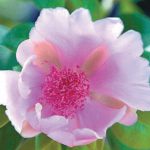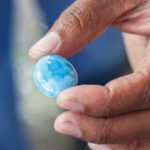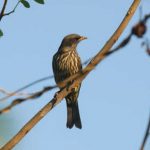
National Symbols
National Flower
 The Bayahíbe Rose (Pereskia quisqueyana), exotic and in danger of extinction, is the national flower of the Dominican Repubic. The rose is a rare cactus that has leafs and a beautiful flower. It can be seen in the National Botanical garden in Santo Domingo.
The Bayahíbe Rose (Pereskia quisqueyana), exotic and in danger of extinction, is the national flower of the Dominican Repubic. The rose is a rare cactus that has leafs and a beautiful flower. It can be seen in the National Botanical garden in Santo Domingo.
Did you know? The Mahogany flower was declared the National Flower on July 16, 1957, by decree 2944, issued by the Héctor Bienvenido Trujillo Molina government. The flower is from the mahogany tree, Swietenia mahogani, considered to be native, and one of the most prized in the world for the quality of its wood.
National Stones
 The Larimar. Is a rare variety of stone or semiprecious rock which was declared a national stone in 2011. Its coloration varies from white, clear blue, greenish blue and dark blue. Although it was found for the first time in 1916, the year 1994 was when Dominican Miguel Méndez and Norman Rilling, a volunteer from the Peace Corps, “rediscovered” the stone on a coastal beach in Barahona. It is said that the stone received its current name from the daughter of Méndez whose name was Larissa and for the color of the mar. Dominicans use the beauty and rarity of the larimar in jewelry and art which they sell at hundreds of gift-shops to tourists and locals.
The Larimar. Is a rare variety of stone or semiprecious rock which was declared a national stone in 2011. Its coloration varies from white, clear blue, greenish blue and dark blue. Although it was found for the first time in 1916, the year 1994 was when Dominican Miguel Méndez and Norman Rilling, a volunteer from the Peace Corps, “rediscovered” the stone on a coastal beach in Barahona. It is said that the stone received its current name from the daughter of Méndez whose name was Larissa and for the color of the mar. Dominicans use the beauty and rarity of the larimar in jewelry and art which they sell at hundreds of gift-shops to tourists and locals.
The Amber. This plant resin converted into rock comes from thousand year old trees and narrow tunnels, and is named amber. The petrified bits that preserve fossilized insects abound in the Cibao area, in the island’s central region. Scientists that search for the quality of amber deposits in the Middle East, Australia, Canada, China, Mexico and the Dominican Republic grant greater value to the Dominican gems, due to their fossil preservation.
A 30 million year old gecko, a 20 million year old mosquito or a species that ceased to exist on the planet several million years ago still exhibit their forms as small museum pieces in an iridescent gem. The majority of the rocks extracted and sold are of yellow and brown colors. A few reddish gems have been found. Also, thanks to local nature, there are some with blue undertones, but they are extremely scarce and therefore very valuable. They have only been found in the Cibao region, while in the East, many pieces have an almost white hue.
Did you know? The Dominican Dirección General de Minería established that the amber deposits are found in sedimentary drainage basins formed by the fusion of shale and arsenics from the Yanigua and Puerto Plata formations from the Eocene-Miocene period. Other deposits are located and extracted in the Cordillera Septentrional, province of Santiago, in the north, in the communities of Los Cacaos and Palo Alto; in the Cordillera Oriental, in the municipality of El Valle of the Hato Mayor province, in the east of the country.
Did you know? Extraction is carried out by hand, using underground mining techniques (shafts and tunnels). The miners that extract the mineral group themselves into cooperatives. The current national production average is approximately 300 pounds per month.
Find out more about this at: http://www.ambermuseum.com/
National Bird
 The Palm Chat, from the Dulidae family, is endemic to Hispaniola and is not related to other species. It lives in flocks and raises its young in a large nest that has various compartments. fruits, flowers and small insects serve as its food. Its size, on average, is 20 centimeters in length. Its body is olive colored, while its wings tend to be green. Its underbelly is the color of café latte or a pale yellow, with brown stripes. The head has a darker color and the beak is strong. Both sexes are similar.
The Palm Chat, from the Dulidae family, is endemic to Hispaniola and is not related to other species. It lives in flocks and raises its young in a large nest that has various compartments. fruits, flowers and small insects serve as its food. Its size, on average, is 20 centimeters in length. Its body is olive colored, while its wings tend to be green. Its underbelly is the color of café latte or a pale yellow, with brown stripes. The head has a darker color and the beak is strong. Both sexes are similar.
The Palm Chat lives in open fields, but prefers palms, in low elevations. To make its nest, it gathers dry twigs, which it places in the top of a palm or other tree. The bed can reach up to two meters wide by one meter high. Various couples undertake the large construction job, which features tunnels and multiple nests.
Its name, Dulus dominicus, is attributed to Carlos Linnacus, who discovered it in 1766.
The American Union of Orinthology includes the Palm Chat in the Dulidae family on its list of birds of the world.


